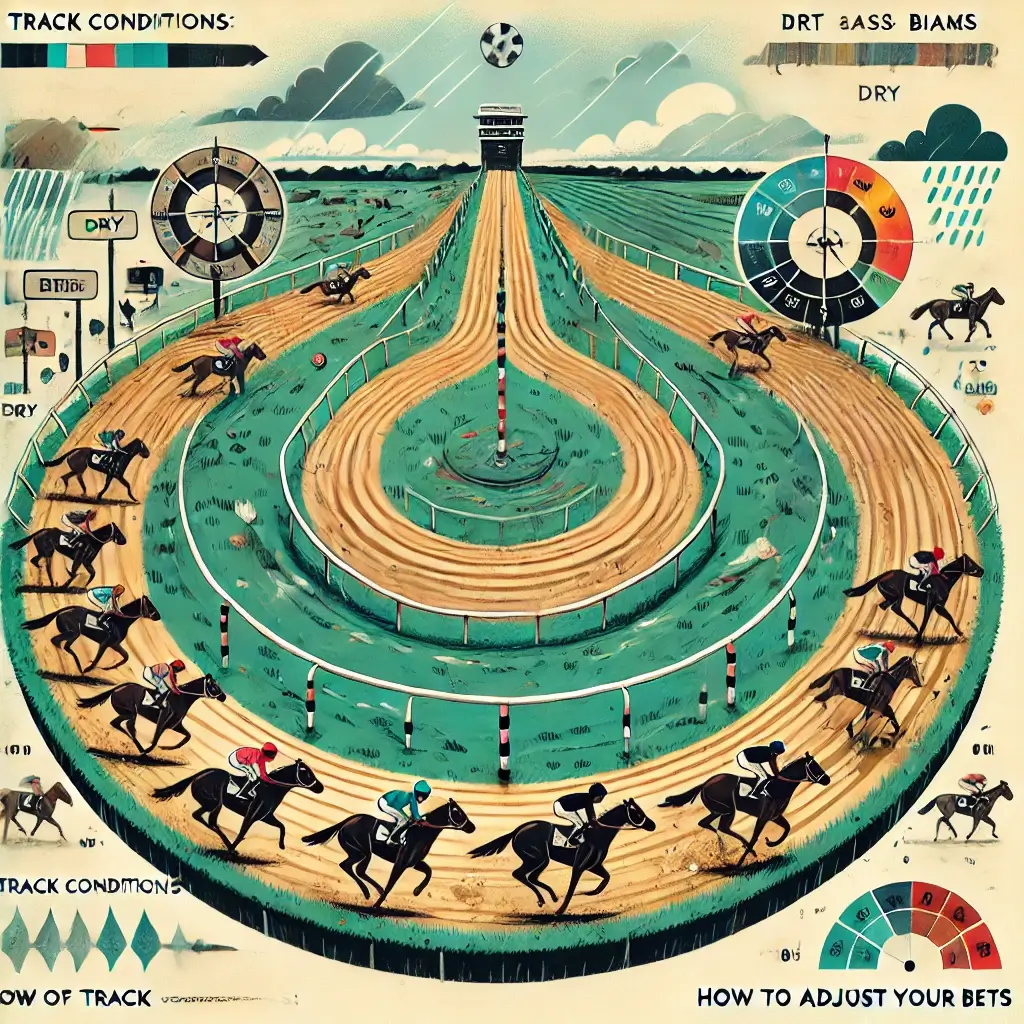The Impact of Track Conditions and Biases: How to Adjust Your Bets
In horse racing, both track conditions and track biases play a crucial role in determining the outcome of a race. Understanding how these factors affect horse performance is key to making informed betting decisions. Whether you're new to betting or an experienced punter, this guide will help you navigate the complexities of track conditions and biases, and adjust your bets accordingly to increase your chances of success.

Understanding Track Conditions
Track conditions refer to the state of the racing surface, which can vary due to weather, maintenance, and the type of surface. Track conditions are typically classified differently depending on the region and the type of surface.
Common Track Condition Ratings
- Firm/Good: A dry, fast track that provides optimal running conditions for most horses.
- Good to Soft: Slightly softer than firm, usually after light rain, offering a bit more give in the ground.
- Soft/Yielding: A softer track that can slow down horses that prefer firmer ground.
- Heavy: A very wet and heavy track, often following significant rainfall, which can be very testing for horses.
- Mud: Extremely soft, wet, and slippery conditions that can significantly affect a horse's performance, often leading to slower race times.
Track Surfaces
Different types of track surfaces also play a role in how horses perform:
- Turf: Grass surfaces that can vary widely based on weather conditions and maintenance. Turf tracks are most common in Europe and Australia.
- Dirt: A packed surface often found in the United States, known for being fast when dry but can become muddy when wet.
- Synthetic (Polytrack, Tapeta, etc.): Man-made surfaces designed to offer consistency regardless of weather, but some horses have distinct preferences for or against synthetic surfaces.
Understanding Track Biases
Track bias refers to a tendency for certain parts of a racetrack to favor horses with particular running styles or starting positions. Biases can develop due to a variety of factors, including track maintenance, weather conditions, and the layout of the track itself.
Common Types of Track Biases
- Inside Bias: When the inside lanes of the track provide an advantage, often due to better maintenance or less wear and tear.
- Outside Bias: Conversely, some tracks may favor horses running on the outside, especially if the inside lanes are softer or more worn.
- Speed Bias: Some tracks favor front-runners who can maintain speed throughout the race, particularly on dirt surfaces where speed is crucial.
- Closer Bias: On the other hand, some tracks favor horses that come from behind, especially in races where the early pace is fast and tiring.
How to Identify Track Biases
- Watch Replays: Reviewing past races at the same track can help you identify any recurring biases. Look for patterns in where the winners are positioned on the track.
- Study Track Reports: Some racing publications and websites offer detailed reports on track biases, providing insights into which lanes or running styles have been most successful.
- Track Maintenance: Pay attention to track maintenance reports, as changes in track preparation (such as harrowing patterns) can create or eliminate biases.
How Track Conditions and Biases Affect Horse Performance
Understanding both track conditions and biases is essential for predicting how a race will unfold. Here’s how these factors typically influence horse performance:
1. Horses That Prefer Firm/Good Ground
- Speed Horses: Horses that rely on speed tend to perform well on firm or good ground where the surface provides minimal resistance.
- Lightweight Horses: Horses with a lighter build often excel on firmer ground, as they are less affected by the impact of the harder surface.
2. Horses That Excel on Soft/Heavy Ground
- Strong, Stamina-Based Horses: Horses with a strong build and good stamina tend to perform well on soft or heavy ground, where their power helps them plow through the slower, more testing conditions.
- Proven Mudders: Some horses are known as “mudders” because they have consistently performed well on wet or muddy tracks. These horses often thrive in soft or heavy conditions.
3. Impact of Track Biases
- Inside vs. Outside Draws: Horses drawn on the inside might have an advantage if there is an inside bias, especially in shorter races where early position is crucial.
- Front-Runners vs. Closers: A speed bias benefits horses that can take the lead early and maintain it, while a closer bias favors those that can make a strong finishing run from behind.
Adjusting Your Bets Based on Track Conditions and Biases
Knowing how track conditions and biases affect the outcome of races allows you to make more informed bets. Here are some strategies to help you adjust your bets accordingly:
1. Analyze Past Performance
Look at how horses have performed on similar track conditions and in the presence of track biases. Horses with a proven record on a specific type of surface or bias are more likely to replicate that success.
- Key Indicators: Use racing forms and databases to check the horse’s past performances on different track conditions and biases. Pay attention to how they performed under similar circumstances.
- Trainer and Jockey Insights: Some trainers and jockeys excel in overcoming certain biases or preparing horses for specific track conditions. Factor this into your analysis.
2. Watch the Weather and Track Reports
Weather forecasts and track maintenance reports can give you valuable insights into how track conditions might change leading up to the race. Adjust your bets based on anticipated changes.
- Rain and Softening Ground: If rain is expected, consider horses that perform well on softer ground. Conversely, if the track is drying out, favor horses that prefer firmer conditions.
- Track Bias Adjustments: Be on the lookout for any changes in track preparation or conditions that might create or neutralize a known bias.
3. Use Multiple Selections
In races where track conditions and biases are uncertain or variable, consider using multiple selections to cover different scenarios.
- Each-Way Betting: This strategy can be particularly useful when the track conditions or biases are likely to produce unexpected results. By betting each-way, you can secure a return even if your horse doesn't win but still places.
- Boxed Bets: In exotic bets like exactas or trifectas, consider boxing your selections to cover different possible outcomes. This can increase your chances of winning in unpredictable conditions.
4. Consider Late Market Moves
Track conditions and biases can lead to significant shifts in the betting market, especially as the race day progresses. Keep an eye on late market moves to see where the smart money is going.
- Market Reaction: Sharp bettors often react quickly to changes in track conditions or the emergence of a bias, and late moves in the betting market can indicate where the money is flowing. If you notice a horse being heavily backed late, it might be due to favorable track conditions or a recognized bias.
Common Mistakes to Avoid
1. Ignoring Track Conditions and Biases
One of the biggest mistakes bettors make is ignoring track conditions and biases entirely. Always consider how these factors will affect the race and adjust your bets accordingly.
2. Overestimating the Impact of Biases
While track biases are important, don’t overestimate their impact. A good horse can sometimes overcome a bias, so always weigh the overall form and quality of the horse.
3. Focusing Only on the Favorite
In adverse conditions or on biased tracks, favorites can sometimes underperform. Be open to exploring other options, especially horses that are proven performers under the specific conditions or biases at hand.
Conclusion
Track conditions and biases are critical factors in horse racing, and understanding how they impact horse performance can greatly improve your betting success. By analyzing past performances, staying updated on weather and track reports, and adjusting your bets accordingly, you can make more informed decisions and increase your chances of winning. Whether you're betting on a firm turf track, a muddy dirt course, or a track with a known bias, the key is to stay adaptable and use these factors to your advantage.
More Betting Guides
Fundamentals of Horse Racing Betting
- Bankroll Management for Horse Racing: Tips to Stay Profitable
- Horse Racing Betting 101: A Beginner’s Guide to Understanding Bets, Racing Forms, and More
- Understanding Odds: How to Maximize Your Winnings
Betting Strategies
- Each-Way Betting: A Safer Approach to Horse Racing Bets
- How to Pick Winners in Horse Racing: Tips from the Pros
- Value Betting in Horse Racing: How to Identify and Capitalize on Undervalued Horses
Advanced Betting Techniques
- Mastering Exacta Betting: From Beginner to Pro
- Mastering Multi-Race Bets: Strategies for Pick 3, Pick 4, Pick 5, and Pick 6 in Horse Racing
- Trifecta and Superfecta Betting: Strategies for Big Payouts
Analysis and Prediction
- How to Analyze Past Performance to Predict Future Success
- Jockey and Trainer Analysis: How to Factor Human Elements into Your Bets
- The Impact of Track Conditions and Biases: How to Adjust Your Bets
Specialized Knowledge
More of our latest tips & picks
💎 Value Tips Finder
Discover horses with high tipster consensus but generous odds

United States
Friday
Friday
Saturday
Saturday
Saturday
Friday
Saturday
Saturday
Friday
Saturday

France

South Africa
Sunday
Saturday

Great Britain

Argentina
Friday
🏇 Upcoming Races
See the most-tipped horses for races just around the corner.

Seb Collins
"This platform has revolutionized how I find winners. I can test different strategies, track performance patterns, and refine my approach with real data. It's incredible how quickly my success rate improved once I started using these tools."



